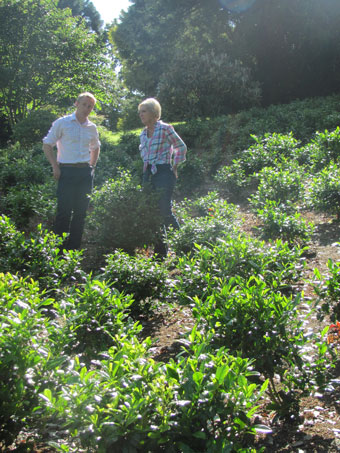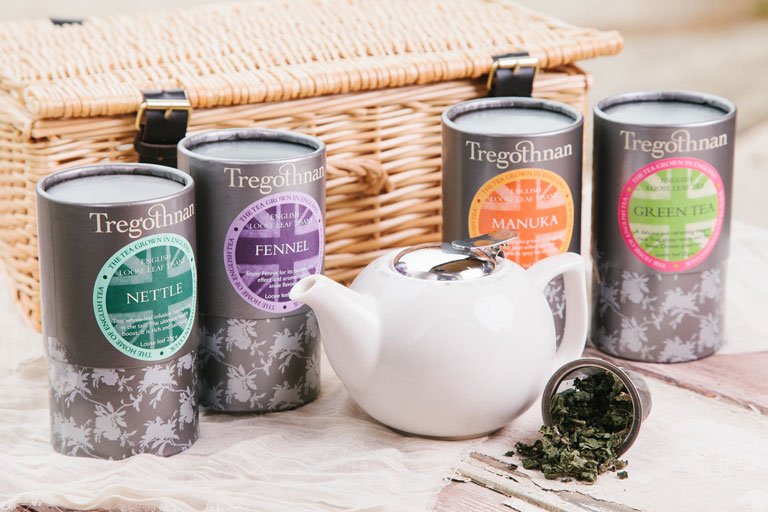
Branding Cornish Tea
By Dan Anthony, Freelance Writer
Tregothnan, the family seat of the Viscount of Falmouth, in the South West of England overlooks the deep sea creek of the river Fal, hidden deep in the Cornish woods between Truro and Falmouth. It’s a landscape that is steeped in time. The current Viscount can trace his connection to this land back to the mid-fourteenth century. Here, it seemed, things never change.
But the Tregothnan estate has a unique feature: its gardens. In the eighteenth and nineteenth centuries, plants were brought back to Britain from all over its expanding empire and the techniques for cultivating them were developed in the walled gardens and greenhouses of the nation’s country houses. Tregothnan’s gardens, warmer than most, situated on the south-facing side of sunny Cornwall, grew to become famous – and a hotbed of horticultural innovation.
Necessity and invention

Tregothnan with food writer and TV presenter Mary Berry at
Tregothnan. The first tea bushes wereplanted on the Estate
in 1998. Now the estate plants around 6,000 bushes a year,
produces 10 tonnes of tea valued at more than GBP 2million
and employs over 70 people. (Photo: Tregothnan.co.uk)
In the 1990s, faced with the problem of maintaining Tregothnan’s unique arboretum and gardens, the then Head Gardener and now Managing Director of Trading at Tregothnan, Jonathon Jones, came up with an idea that has not only changed the fortunes of Evelyn Arthur Boscawen, heir to the estate, but may also alter our perception of Britain’s most iconic drink: tea.
”We knew we needed to do something different to help maintain and develop the 100 acre botanical gardens at Tregothnan,” said Jonathon. “The usual route would be to open the gardens up and encourage visitors – but that would have changed their unique character. Instead we hit upon a home-grown solution.”
Tea bushes (Camellia sinensis), were already grown on a small scale at the estate - Jonathon’s idea went a little further. Could the warm, wet, frost-free, micro-climate of the Fal Valley sustain the UK’s only commercial tea plantation? Good gardeners like experiments – there was only one way to find out and the risk paid off.
“The first tea bushes were planted in 1998,” Jonathon said. “By 2005, the year in which Tregothnan’s first European Community Trade Mark was registered, the bushes had matured and we were picking, marketing and selling home-grown Tregothnan tea. Now we plant around 6,000 bushes a year.”
Branding
“The development of the Tregothnan brand was a response to an urgent need to sustain our unique gardens,” Jonathon explained. “Last year we produced ten tonnes of tea with a value in excess of GBP2million. The estate employs over 70 people and we’re now expanding our horizons.”
British exports into the burgeoning Chinese economy are usually associated with technology, raw materials, IT and financial services. Jonathon Jones and his team at Tregothnan have added tea to the list. Cornish tea is in demand in India too. In August 2014, the Indian High Commissioner attended a ceremony at Tregothnan at which he planted a tea bush. Tregothnan supplies supermarkets and caterers throughout the UK with English tea, its unique selling point being that it was actually grown here – down in the secret garden. The appeal of the high-quality tea is backed by a brand and a story tea drinkers can’t resist. And Tregothnan’s revival isn’t just about tea: flowers, honey and other products from the estate are all being produced with a view to UK and global markets.

Jonathon estimates that growth in tea sales from Tregothnan can be expanded up to tenfold. But the success of Tregothnan tea has revealed a new, even bigger challenge. Faced with the “coffification” of the high street, he believes the future of tea drinking depends on rebranding and re-engaging with the whole idea of drinking tea and capturing the public’s imagination. That is why he is pitching British tea, Tregothnan style, as new, fresh and with almost limitless potential.
Sales of tea
A staggering 165 million cups of tea are drunk every day in the UK. For the tea growers of Tregothnan the challenge is clear: tea as a product must develop with the times. Young consumers increasingly believe that “tea is cool”. Jonathon is determined to reinforce this trend. His pioneering spirit backed up with a wealth of gardening experience, and a vision of what tea-drinking can become are proving key drivers of the success of Tregothnan’s new brew.
“I don’t think we’ve felt more confident than at present. The potential for export has never been stronger,” Jonathon said. “Cornish tea is the great undiscovered drink. We are proud to be the only producer actually growing tea in the UK. Finally, one of Britain’s great institutions has found a home on British soil.”
The WIPO Magazine is intended to help broaden public understanding of intellectual property and of WIPO’s work, and is not an official document of WIPO. The designations employed and the presentation of material throughout this publication do not imply the expression of any opinion whatsoever on the part of WIPO concerning the legal status of any country, territory or area or of its authorities, or concerning the delimitation of its frontiers or boundaries. This publication is not intended to reflect the views of the Member States or the WIPO Secretariat. The mention of specific companies or products of manufacturers does not imply that they are endorsed or recommended by WIPO in preference to others of a similar nature that are not mentioned.